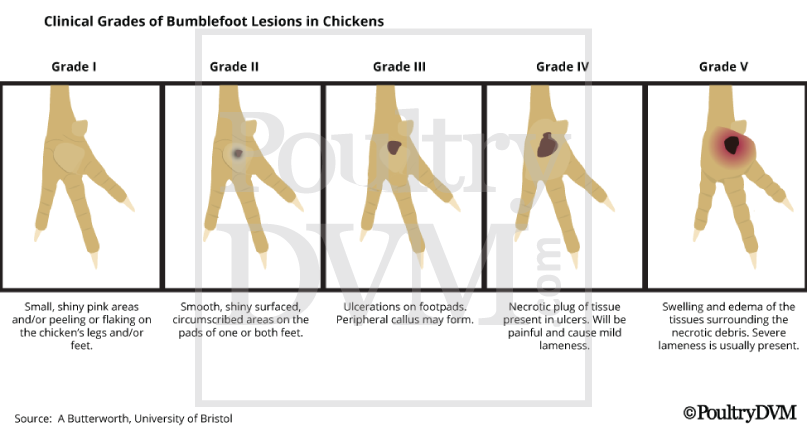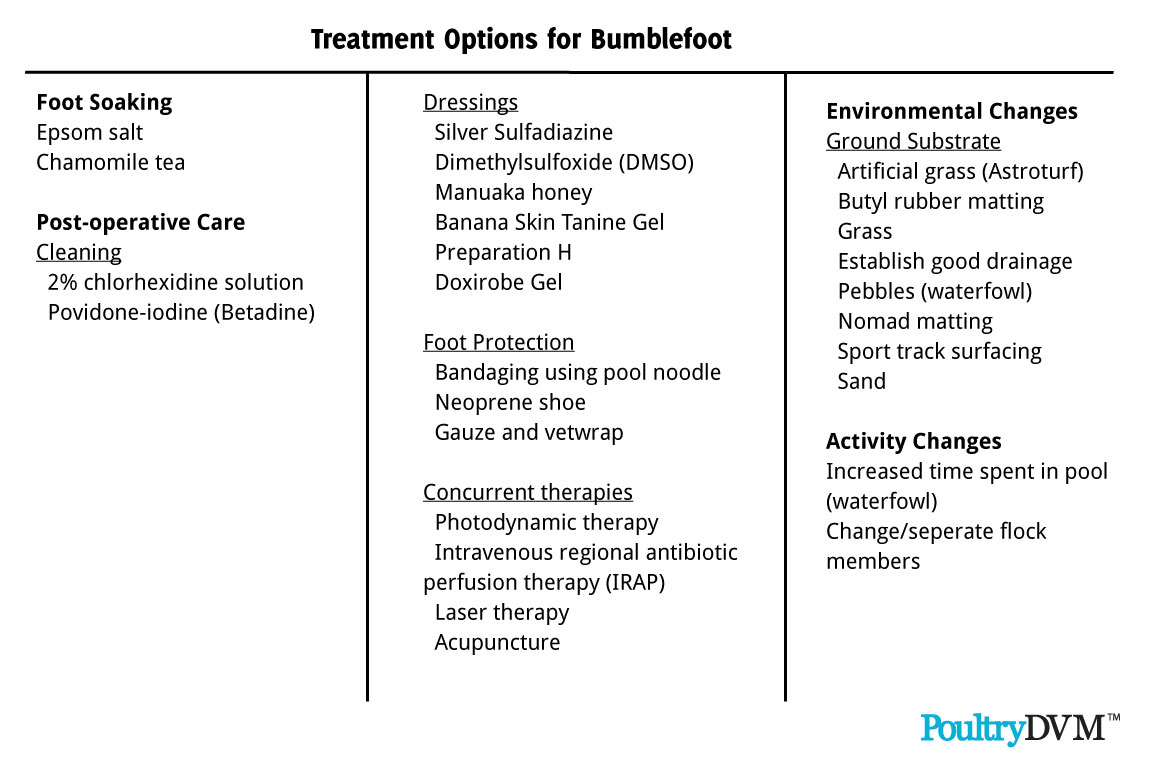Bumblefoot, also known as pododermatitis, is a common inflammatory condition affecting the bottom of the chicken's foot. The most frequent presentation is the presence of a hard, pus-filled abscess covered by a brown to black colored scab. There will also be varying degrees of swelling, heat and reddening of the skin in the area of the scab. As the severity of the infection increases, so does the pain, and chickens are often reluctant to walk and/or appear lame.
Bumblefoot is a common problem for most birds kept in captivity, including penguins, flamingos, raptors, and waterfowl. As such, consideration for prevention of bumblefoot should be incorporated into the design of your flock's housing, and daily management routine. Factors which predispose birds to developing bumblefoot include:
- Large body size: The heavier the bird, the more pressure they will exert on the bottom of their feet. Thus, heavier breeds are more at risk of bumblefoot.
- Skin wounds: Any type of foot injury, even minor abrasions, provide a route for bacteria to enter, resulting in bumblefoot.
- Overgrown toe nails: Most chickens will probably require their toe nails to be periodically trimmed, to prevent them from becoming too long. Otherwise, it can interfere with their ability to move and perch normally.
- Poor or imbalanced diet: If chickens aren't receiving a balanced diet, complete with enough vitamin A and biotin, it can impact their skin integrity, resulting in dry, flaky skin. This decreases the strength of their skin, which acts as a barrier to protect their feet from invasion by bacteria.
- Leg or foot deformities: Chickens with leg or foot deformities often results in unequal or abnormal pressure placed on the foot.
- Bullied birds: Chickens who are on the bottom of the pecking order are more likely to be frequently chased, thus increasing their activity level and pressure exerted on feet if they are frequently jumping and landing to get away from other birds.
Bumblefoot Stages
The severity of bumblefoot is graded using a 5-point scale. During the early stages of bumblefoot, it may initially appear as a small, superficial lesion, rough abrasion, or mild discoloring of the foot. However, once there is a breakdown in the skin barrier, it provides a direct opening for opportunistic bacteria to enter and cause infection. Once the foot is infected, chickens may often begin to show slight behavioral changes (associated with onset of pain caused by the infection), and varying degrees of lameness.

- Grade 1: Loss of definition of the epidermis (seen as a shiny, reddened surface or small lesion), with no apparent underlying infection.
- Grade 2: Infection of underlying tissues in direct contact with the surface lesion with no gross swelling.
- Grade 3: Abscess state; infection with serous or caseous fluid draining from a fibrotic lesion.
- Grade 4: Infection with swelling of underlying tissues involving deep vital structures. Usually, a chronic wound at this stage, which may or may not be concurrently causing tenosynovitis, arthritis, and/or osteomyelitis.
- Grade 5: Crippling deformity and loss of function.
Bumblefoot Treatment Options
Treatment of bumblefoot depends on the stage of the infection. Once an infection is established, the disease progresses quickly.
Early stages are much easier to treat and may only require simple changes to the environment and/or management practices. If infection is present (which is usually the case when there is any ulceration, swelling, and/or inflammation present), then surgical debridement, post-surgical care, and antibiotics are usually necessary.
Post-surgical care consists of bandage and wound management, supportive care and maintaining a very clean environment for healing. Often, irrigation of the wound is necessary with sterile saline or 0.5% chlorhexidine, and protective ball bandaging or application of a custom-made polypropylene foam shoe.
- Environmental Modifications: Modification of environment or management practices.
- Foot soaks: Soaking the foot in warm water with or without Epsom salts or chlorhexidine solution helps to soften the hardened, proliferative, scabbed tissue as well as using keratin-softening agents.
- Bandaging: Bandaging the foot with colloidal dressings or medical honey or similar product until it is completely healed also helps keep the area clean and moist to encourage healing. A variety of bandages have been described such as “ball” in which the foot is bandaged into a ball, a “snowshoe” in which the bandage is flat bottomed to disperse the weight over a larger surface area, or a bandage that puts no weight on the bottom of the foot by strapping a U-shaped bar to the leg or making a donut with a pool noodle or other material. Changing the bandage frequently to keep it clean and dry is necessary.
- Debridement surgery, only performed by your veterinarian.
- Antibiotics: Antibiotics are best selected based on culture (both aerobic and anaerobic) of the wound and antibiotic sensitivity results, to ensure compatibility. The most commonly used antibiotics include cephalosporins, fluoroquinolones, lincomycin, and clindamycin. If osteomyelitis is present, then enrofloxacin and chloramphenicol are often good choices.

